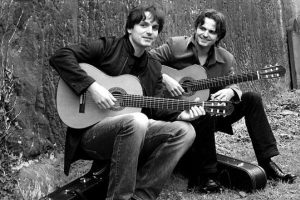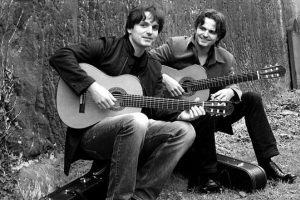
Photo by Peter Goodbody
The recital, presented by the Omni Foundation for the Performing Arts and San Francisco Performances (for which they are Guitar Artists in Residence for two more years), began with Mozart’s Overture to La clemenza di Tito. The piece burst forth suddenly and dramatically with a combination of strummed and plucked chords that astonishingly matched the effect of the fortissimo that Mozart wrote for full orchestra. The Katonas’ arrangement, based on one done by the composer’s contemporary Mauro Giuliani, increased the interest by dividing the musical material equally between the two instruments. Their performance was alternately assertive and delicate, and the dramatic arc was finely paced.
Judging from audience comments, the title of Vivaldi’s Trio Sonata in G Minor, RV 85, required some explanation. Typically, a Baroque trio sonata was written for two solo melodic instruments, which played with a continuo group that provided harmonic and rhythmic accompaniment, thus making three parts and leading to the name trio sonata. The work performed Saturday was originally written for violin, lute, and continuo and arranged for two guitars by the Katona Twins. Some beautiful coloristic effects were inevitably lost, though the exquisite balance of the guitar duo more than compensated and made Vivaldi’s elegant counterpoint perfectly clear.
Villa-Lobos’ Chôros No. 5: Alma Brasileira (Brazilian soul) begins and ends with an expressive serenade featuring melancholy themes and pulsing accompaniment, evocative of the music of the street musicians of Rio de Janeiro around 1900. The vigorous central section brought to mind the composer’s portraits of the Amazon rain forest, and the duo interpreted it with sharply etched power.
Also from Brazil, Astor Piazzolla’s Tango Suite was written for Sergio and Odair Assad and has been an important part of their repertoire for over 20 years. It was good to hear the younger Katona Twins add this masterpiece into their own repertoire in such a convincing manner. The opening Allegro (watch and listen) begins with a lively figure accompanied by an elaborate percussive part on the second guitar. By hitting the instrument in different places, Peter Katona produced various percussive timbres and strikingly began a three-part form that had a gentle central section. The second movement, Andante rubato, showcased a sweet, improvisatory melody with widely ranging melodic shapes. The final Allegro was the most agitated of the three movements and was full of bright, rapid chords; speedy single lines; and a touch of chromaticism. Even in the gentle middle section the Katonas retained a feeling of energy and zest.
Canadian Derek Charke composed Time’s Passing Breath for guitar duo plus a prerecorded background of bells. The guitar writing, compared to the other music on the program, was relatively bland and unidiomatic, though the music was nicely constructed and the bells were undeniably lovely.
Rhythm Fleet in the Feet
Paco De Lucia’s Cepa Andaluza (Andalusian heritage) is in the style of a traditional flamenco bulerías, an extremely fast and asymmetrical dance frequently performed with audience clapping and shouts of encouragement to the performers. The Katonas added foot tapping (a bit out of sync) and percussion on the guitars, capturing the feeling of a fiery flamenco performance.Some of the most refined playing of the evening was heard in the Three Sonatas of Domenico Scarlatti. The Sonata in E Minor, K. 115, presented a collection of highly varied material unified by the composer’s command of harmony. The Sonata in C Minor, K. 481, showcased a long-winded cantabile melody. Providing a brilliant conclusion was the Sonata in D Minor, K. 141, with its rapid repeated notes, scales, and arpeggios.
The recital concluded with Rossini’s Overture to Il barbiere di Siviglia, well-known to listeners from numerous orchestral performances, as well as from its use in Bugs Bunny cartoons, The Simpsons, the Beatles movie Help!, the Seinfeld TV series, and many other pop culture productions. With such a history, the piece is bound to bring smiles to the faces in the audience. The Katona Twins played with both the grandiosity and the lightness of spirit called for in Italian opera of the classical era.

